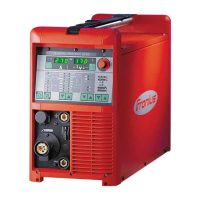124
Terms and abbre-
viations
(continued)
NTC resistors:
NTC = negative temperature coefficient. These resistors have high resistance at low
temperatures. As long as the operating temperature has not been reached, the high
resistance ensures the limitation of the starting current. Shortly after switching on, the
current limit is raised as a result of the rapid heating of the NTC resistors.
PTC resistors:
PTC = positive temperature coefficient These resistors acquire a higher resistance as
the temperature rises. Since the resistor temperature rises as the current increases, the
current is automatically limited.
PFC:
Power factor control Ensures sinusoidal power consumption, for
- supporting an optimum degree of efficiency
- preventing reactions on the mains supply
Voltage doubling:
Ensures that the open circuit voltage and welding voltage are increased at greater arc
lengths. The voltage doubling contributes considerably to optimum ignition properties
and a stable arc.
Segment display:
When a software fault appears: Second display level displays more detailed information
on localising the fault (see „fault location aid“ section)
Software service module:
The software service module helps determine the hardware and software configuration
for the power source and peripheral devices. The display of the following components is
especially useful:
- Design and version of the power sources and peripheral devices.
- The accompanying software modules and PC boards.
- Indication of serial numbers for some machines
In addition, the software service module allows you to call up the relevant order infor-
mation for the selected options.
Temperature/current converter chip:
is used in the temperature sensor. +A specially endowed semi-conductor ensures
conversion of the measured temperature into a corresponding voltage signal. The
voltage signal arrives at the UST2B PC board (central control and regulation unit), and
the computer uses it to calculate the actual temperature.

